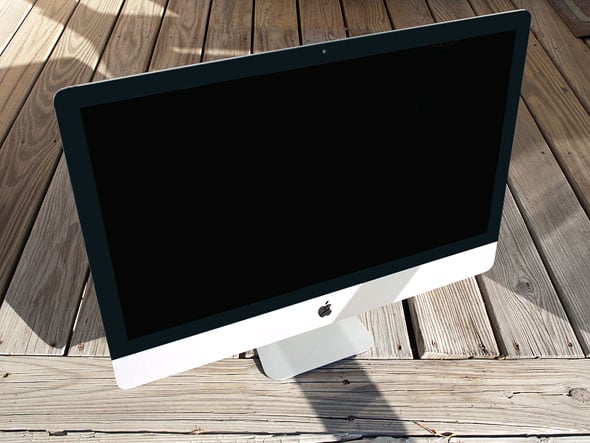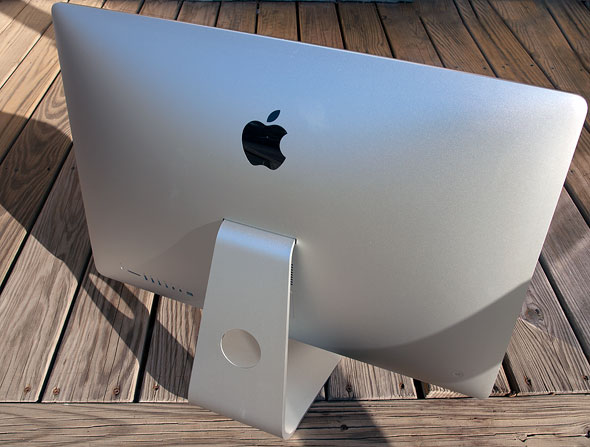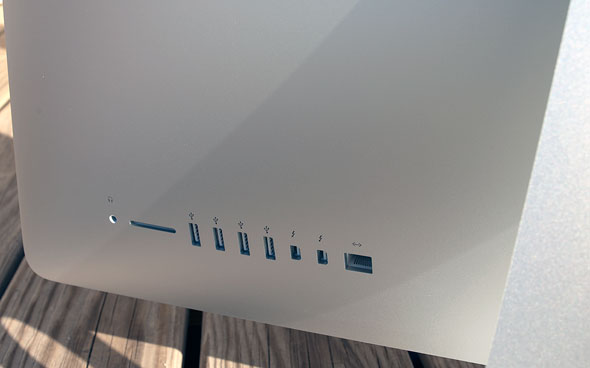Apple 27-Inch iMac (Late 2013) Review, Haswell Inside
Design & Layout
It's interesting to look back at the evolution of the iMac. It started back in 1998 with the introduction of a bulky CRT monitor form factor, which was slightly refined in 2000. Two years later, Apple revamped the design with a flat screen panel, and in 2004, the company altered the stand and overall design once more. It's that model that each of the next four major alternations evolved from.



The current generation iMacs sport either a 21.5-inch IPS display with a Full HD 1080p (1920x1080) resolution, or a 27-inch IPS display with a 2560x1440 resolution. It's the larger model we received, and while it's not quite as big as a 30-inch panel, the resolution is comparable (most 30-inch monitors rock a 2560x1600 resolution), offering up nearly as much on-screen real estate.
Apple makes some of the best looking monitors around, and the iMac is no exception. A black bezel frames the viewable area, and underneath that is an aluminum strip with Apple's logo sitting dead center. This strip hides the built-in stereo speakers and also houses the integrated 802.11ac Wi-Fi and Bluetooth functionality. The stereo speakers put out a decent amount of volume and are much higher quality that what you'll find in most all-in-one systems, which often sound tinny. It's clear these speakers are here to enhance the experience and aren't included simply as an afterthought.
Up top is the FaceTime HD camera flanked by dual microphones and an ambient light sensor. The dual mics use beam-forming technology for clearer dictation and also to reduce background noise.
Apple makes some of the best looking monitors around, and the iMac is no exception. A black bezel frames the viewable area, and underneath that is an aluminum strip with Apple's logo sitting dead center. This strip hides the built-in stereo speakers and also houses the integrated 802.11ac Wi-Fi and Bluetooth functionality. The stereo speakers put out a decent amount of volume and are much higher quality that what you'll find in most all-in-one systems, which often sound tinny. It's clear these speakers are here to enhance the experience and aren't included simply as an afterthought.
Up top is the FaceTime HD camera flanked by dual microphones and an ambient light sensor. The dual mics use beam-forming technology for clearer dictation and also to reduce background noise.
 |
 |
We don't want to belabor the point about how thin the iMac is, but it truly is a marvel in engineering, especially when you stop and think about the hardware inside. This isn't an underpowered system with janky components shoved inside, but a reasonably powerful all-in-one with some of the latest hardware available. It also feels incredibly solid and not the least bit flimsy even though it hardly takes up an space on your desktop.
Not everything is peaches and cream, however (or Apple cobbler, if you will). If we're to find fault with the iMac, it would be the stand, which only offers tilt adjustments. You can't raise or lower the display, nor does it pivot or rotate. These aren't deal killers by any means, but they are tradeoffs that are worth mentioning.
Not everything is peaches and cream, however (or Apple cobbler, if you will). If we're to find fault with the iMac, it would be the stand, which only offers tilt adjustments. You can't raise or lower the display, nor does it pivot or rotate. These aren't deal killers by any means, but they are tradeoffs that are worth mentioning.

Around back is a second Apple logo plastered onto the aluminum chassis. If you were able to detach the stand (and you can't), the iMac would look like a ginormous iPad, only heavier, more powerful, and without the touchscreen support, a feature that's sorely lacking here.
On the bottom left are a series of connectivity options, including a headphone jack, SD card slot, four SuperSpeed USB 3.0 ports, two Thunderbolt ports, and a gigabit Ethernet port. The power cord plugs right into the center of the iMac's backside, and you can route the cable through a circular cutout in the stand.
Aesthetically, Apple made the right decision to banish every single port to the iMac's backside where they're out of sight, but functionally, it's a bit of an inconvenience. How much of an inconvenience depends on how often you plug in external devices like USB thumb drives, especially since the included keyboard doesn't come with any built-in USB ports.
On the bottom left are a series of connectivity options, including a headphone jack, SD card slot, four SuperSpeed USB 3.0 ports, two Thunderbolt ports, and a gigabit Ethernet port. The power cord plugs right into the center of the iMac's backside, and you can route the cable through a circular cutout in the stand.
Aesthetically, Apple made the right decision to banish every single port to the iMac's backside where they're out of sight, but functionally, it's a bit of an inconvenience. How much of an inconvenience depends on how often you plug in external devices like USB thumb drives, especially since the included keyboard doesn't come with any built-in USB ports.







